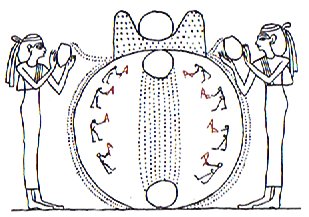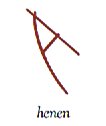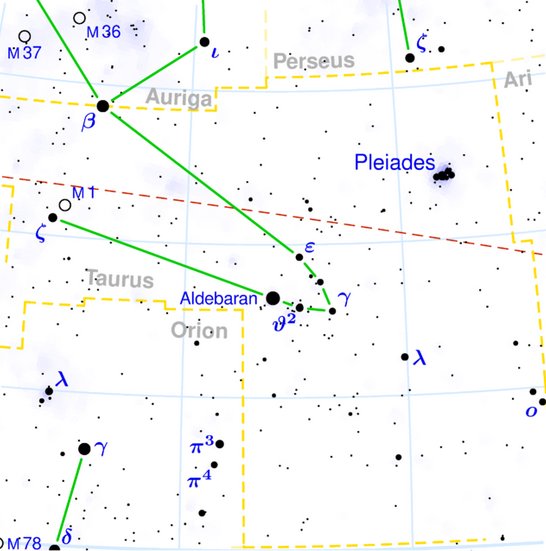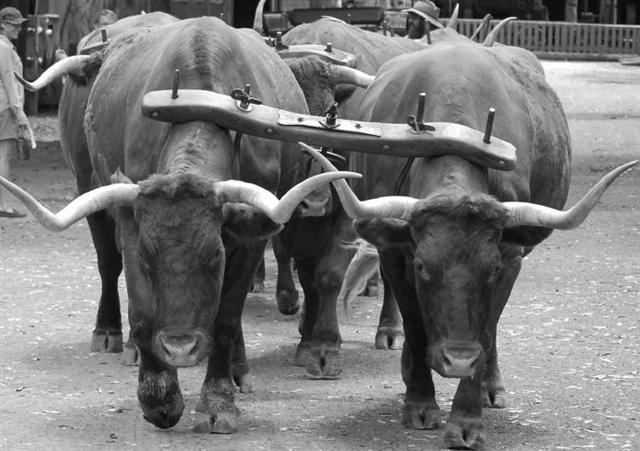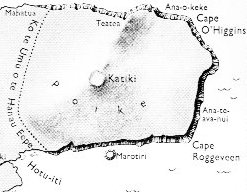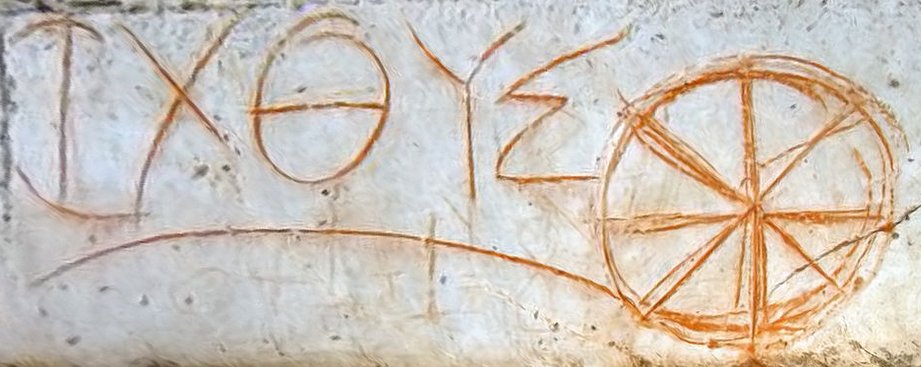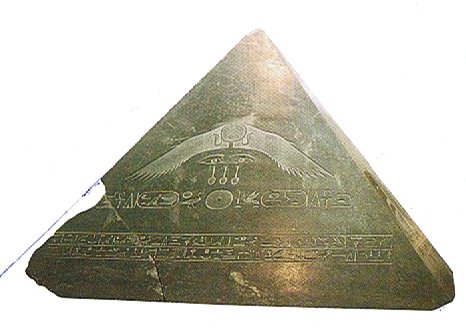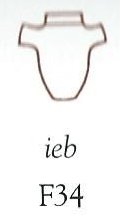105. The woman at left (in the north) is slightly shorter (younger) than the woman at right (in the south). She has space between her left elbow and the globe - she represents Spring:
For purpose of reference, my numbers:
There are 8 henen signs around these 9 rivers:
The sacred geography of 'the 8th Island' could have been designed from recognizing a similarity with the Taurus configuration:
If so, then it would have been natural to let the G text begin here:
At the beginning of our own alphabet is the letter A, which is a descendant of the sign for the Bull:
The connection between a plough (henen) and the alpha bull was obvious. The iron plough enabled a cultural revolution, but it was heavy and hard work and it was necessary to tame the Bull.
I guess 8 times working the ground meant 8 springs, i.e. pars pro toto 8 years. From there we can guess the pair of women were representing Venus as morning star respectively Venus as evening star.
... After five complete cycles totaling 2,920 days, the movement of Venus will fill eight idealized years of 365 days each and come within hours of spanning 99 lunations ...
Decisive in definining the sacred geography of Easter Island should have been the 'ditch of fire' separating the headland in the east, at the place aloft (Poike) from the rest of the island:
... 'fire' is actually a great circle reaching from the North Pole of the celestial sphere to its South Pole ... In Ga1-2 there is a pair of stars at left and these could have referred to the Eye (ε) of the Bull (above) and the pair θ¹ θ² (below) - connected like the rope between the pair of 'horns' in henen.
... In the inscriptions of Dendera, published by Dümichen, the goddess Hathor is called 'lady of every joy'. For once, Dümichen adds: Literally ... 'the lady of every heart circuit'. This is not to say that the Egyptians had discovered the circulation of the blood. But the determinative sign for 'heart' often figures as the plumb bob at the end of a plumb line coming from a well-known astronomical or surveying device, the merkhet. Evidently, 'heart' is something very specific, as it were the 'center of gravity' ... See Aeg.Wb. 2, pp. 55f. for sign of the heart (ib) as expressing generally 'the middle, the center'.
And this may lead in quite another direction. The Arabs preserved a name for Canopus - besides calling the star Kalb at-tai-man ('heart of the south') ... Suhail el-wezn, 'Canopus Ponderosus', the heavy-weighing Canopus, a name promptly declared meaningless by the experts, but which could well have belonged to an archaic system in which Canopus was the weight at the end of the plumb line, as befitted its important position as a heavy star at the South Pole of the 'waters below'. Here is a chain of inferences which might or might not be valid, but it is allowable to test it, and no inference at all would come from the 'lady of every joy'. The line seems to state that Hathor (= Hat Hor, 'House of Horus') 'rules' the revolution of a specific celestial body - whether or not Canopus is alluded to - or, if we can trust the translation 'every', the revolution of all celestial bodies. As concerns the identity of the ruling lady, the greater possibility speaks for Sirius, but Venus cannot be excluded; in Mexico, too, Venus is called 'heart of the earth'. The reader is invited to imagine for himself what many thousands of such pseudo-primitive or poetic interpretations must lead to: a disfigured interpretation of Egyptian intellectual life ... Barthel (in his The Eighth Island) has commented regarding the distribution of the kuhane stations: "For all the names in the first third of the list, the use of the definite article (te, pl. nga) is characteristic. The last third of the way to Anakena is different from the preceding eight pairs of place names because of the difference in direction (south / north and east / west). This distribution of characteristics leads one to believe that the path of the dream soul with its twenty-four names is divided into three segments. Assuming such a division, it turns out that the real distance of each of the three segments (Motu Nui - Te Pou, Huareva - Poike, and Maunga Pua Katiki - Maunga Peke Tau O Hiti) is about the same - that is, approximately 10 km by air."
But he seems to have been mistaken in pointing out Maunga Peke Tau O Hiti as station number 24: ... The dream soul came to Rangi Meamea and looked around searchingly. The dream soul spoke: 'Here at last is level land where the king can live.' She named the place 'Rangi Meamea A Hau Maka O Hiva'. The mountain she named 'Peke Tau O Hiti A Hau Maka O Hiva'. The dream soul moved along a curve from Peke Tau O Hiti to the mountain Hau Epa, which she named 'Maunga Hau Epa A Hau Maka O Hiva' ... And excluding Nga Kope Ririva - which did not belong to Hau Maka but to Taanga - brings the number down from 24 to 23. That is to say that the beginning of a time enumeration was like 0. Time flows and not until its first measure has been completed in full can there be 1 notched into the wood.
There were 7 stations with names beginning with TE. ... He [Eric Thompson] established that one sign, very common in the [Mayan] codices where it appears affixed to main signs, can be read as 'te' or 'che', 'tree' or 'wood', and as a numerical classifier in counts of periods of time, such as years, months, or days. In Yucatec, you cannot for instance say 'ox haab' for 'three years', but must say 'ox-te haab', 'three-te years'. In modern dictionaries 'te' also means 'tree', and this other meaning for the sign was confirmed when Thompson found it in compounds accompanying pictures of trees in the Dresden Codex ... The Taurus constellation is open between the pair of the points of the horns in the west, likewise was the western part of Easter Island not a part of the 24 stations leading up to Anakena. Although the kuhane continued with her exploration also beyond the place for the Landfall of the King: ... The dream soul went to the other side of the mountain Hau Epa. As soon as the dream soul looked around, she saw the sand (beach), which was very white and light. She remained there and explored everything. After she had looked around carefully, the dream soul of Hau Maka said, 'Ah! This is the place that will serve as a residence for the king. She named the place 'Oromanga A Hau Maka O Hiva' and also named the neighboring bay 'Hanga Moria One A Hau Maka O Hiva'. The dream soul stepped forth lightly and reached Papa O Pea. She carefully looked around for a place where the king could settle down after his arrival and gather his people around (? hakaheuru). Having assembled his people (?) and having come down [from the east], he would then go from Oromanga to Papa O Pea, so went the speech of the dream soul. She named the place 'Papa O Pea A Hau Maka O Hiva'. She then hastened her steps toward Ahu Akapu. There she looked again for a residence of the king. Again the dream soul of Hau Maka spoke: 'May the king assemble his people (?) and may he come in the midst of his people from Oromanga to Papa O Pea. When the king of Papa O Pea has assembled his people (?) and has come to this place, he reaches Aha Akapu. To stay there, to remain (for the rest of his life) at Ahu Akapu, the king will abdicate (?) as soon as he has become an old man'. She named the place 'Ahu Akapu A Hau Maka O Hiva'. The (entire) land she named 'Te Pito O Te Kainga A Hau Maka O Hiva'. The dream soul turned around and hurried back to Hiva, to its (Home)land, to Maori. She slipped into the (sleeping) body of Hau Maka, and the body of Hau Maka awakened. He arouse and said full of amazement 'Ah' and thought about the dream ... 24 + 4 + 1 = 29. And 29 / 24 * 366 = 442¼ = 365¼ + 77. And 15 * 29½ = 442½.
The 'water droplets of time' from the urns of the pair of women should be counted too, although the resolution of the picture is not good enough for achieving certain results - which implies I might have unintentionally manipulated the numbers, made more of them than was intended by the creator of the picture, or less.
6 * 61 = 366 was the measure for the right ascension year. The 9 'rivers of time' inside the globe could have been counted as 233 (= 313 - 80) right ascension nights and possibly we should add 4 (= 84 - 80) for the right elbow of Autumn. 233 + 4 = 237 = 8 * 29½ + 1.
|
||||||||||||||||||||||||||||||||||||||||||||||||||||||||||||||||||||||||||||||||||||||||||||||||||||||||||||||||||||||||||||||||||||||||||||||||||||||||||||||||||||||||||||||||||||||||||||||||||||||||||||||||||||||||||||||||||||||||||||||||||||||||||||||||||||||||||||||||||||||||||
